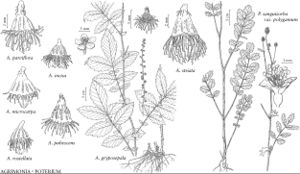Difference between revisions of "Agrimonia rostellata"
Beitr. Bot. 1: 42. 1842.
FNA>Volume Importer |
imported>Volume Importer |
||
| (5 intermediate revisions by 2 users not shown) | |||
| Line 12: | Line 12: | ||
}}{{Treatment/ID/Special_status | }}{{Treatment/ID/Special_status | ||
|code=F | |code=F | ||
| − | |label= | + | |label=Illustrated |
}} | }} | ||
|basionyms= | |basionyms= | ||
| Line 18: | Line 18: | ||
|name=Eupatorium rostellatum | |name=Eupatorium rostellatum | ||
|authority=(Wallroth) Nieuwland | |authority=(Wallroth) Nieuwland | ||
| + | |rank=species | ||
}} | }} | ||
|hierarchy=Rosaceae;Rosaceae subfam. Rosoideae;Rosaceae tribe Agrimonieae;Agrimonia;Agrimonia rostellata | |hierarchy=Rosaceae;Rosaceae subfam. Rosoideae;Rosaceae tribe Agrimonieae;Agrimonia;Agrimonia rostellata | ||
| Line 41: | Line 42: | ||
-->{{#Taxon: | -->{{#Taxon: | ||
name=Agrimonia rostellata | name=Agrimonia rostellata | ||
| − | |||
|authority=Wallroth | |authority=Wallroth | ||
|rank=species | |rank=species | ||
| Line 55: | Line 55: | ||
|publication title=Beitr. Bot. | |publication title=Beitr. Bot. | ||
|publication year=1842 | |publication year=1842 | ||
| − | |special status=Endemic; | + | |special status=Endemic;Illustrated |
| − | |source xml=https:// | + | |source xml=https://bitbucket.org/aafc-mbb/fna-data-curation/src/2e0870ddd59836b60bcf96646a41e87ea5a5943a/coarse_grained_fna_xml/V9/V9_514.xml |
|subfamily=Rosaceae subfam. Rosoideae | |subfamily=Rosaceae subfam. Rosoideae | ||
|tribe=Rosaceae tribe Agrimonieae | |tribe=Rosaceae tribe Agrimonieae | ||
Latest revision as of 23:57, 5 November 2020
Herbs, 4–10 dm. Roots: tubers fusiform. Stems with glistening stipitate-glandular hairs and hirsute (hairs stiff, sparse to scattered, erect, 1–2 mm). Leaves: mid cauline stipules ± falcate to ± 1/2-ovate, margins often deeply incised; major leaflets 3–11 (mid cauline 5–7), minor 0–1(–2) pairs; major leaflet blades obovate to broadly elliptic to elliptic, terminal largest, largest of these 3.4–10.5 × 1.7–5.6 cm, margins serrate, apex acute to obtuse, abaxial surface glistening with sessile-glandular hairs (often shining) and hirsute (hairs sparse to scattered, 1 mm). Inflorescences: axes glistening with sessile-glandular hairs and ± ascending-hirsute (hairs stiff, sparse to scattered, 0.5–1 mm). Flowers ± alternate. Fruiting hypanthia hemispheric, 1–3.1 × 1.8–3.9 mm, obscurely sulcate, hooked bristles in 2–3 circumferential rows, proximal row spreading to ± 90°, usually glistening with sessile-glandular hairs.
Phenology: Flowering Jul–mid Sep.
Habitat: Edges, open spaces, and thickets, deciduous or mixed deciduous woods
Elevation: 0–1100 m
Distribution

Ala., Ark., Conn., Del., D.C., Fla., Ga., Ill., Ind., Kans., Ky., La., Md., Mich., Miss., Mo., N.J., N.Y., N.C., Ohio, Okla., Pa., S.C., Tenn., Tex., Va., W.Va., Wis.
Discussion
Selected References
None.
